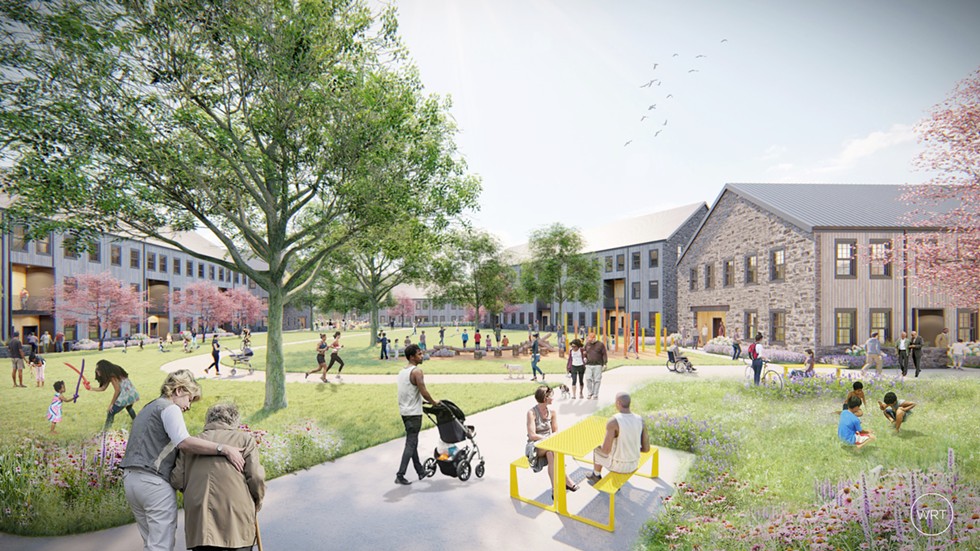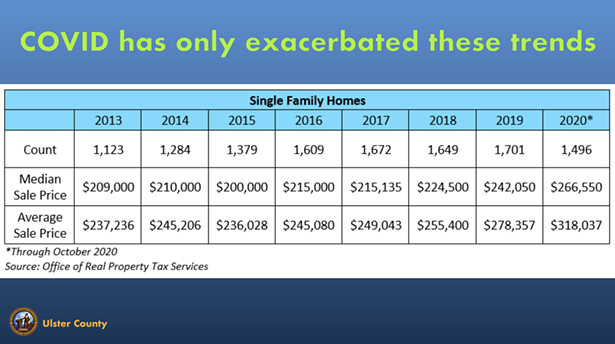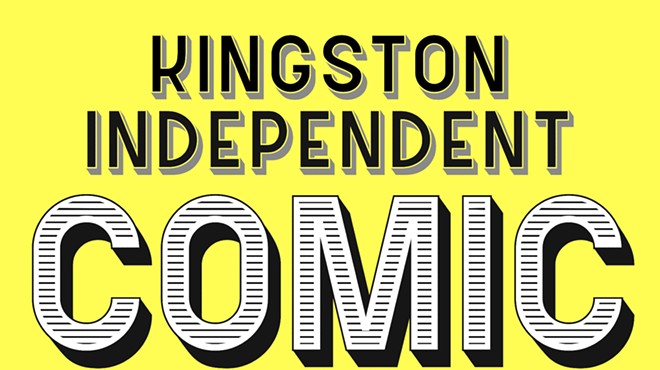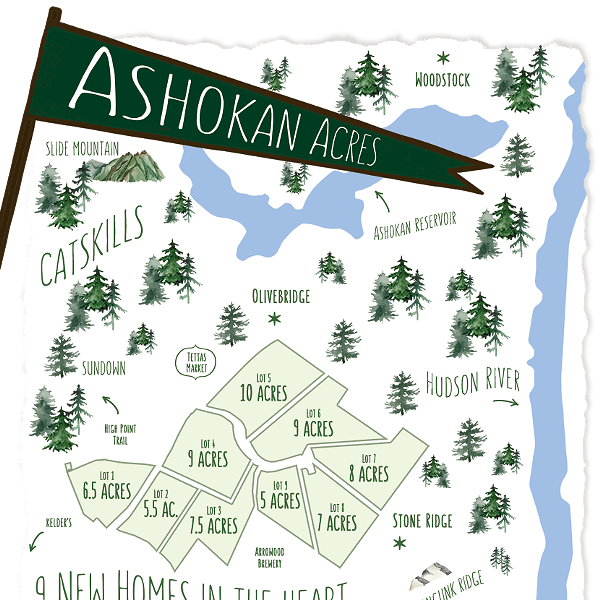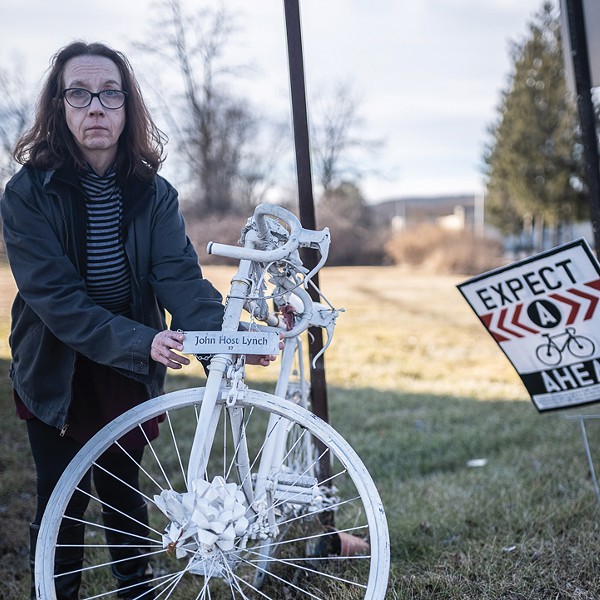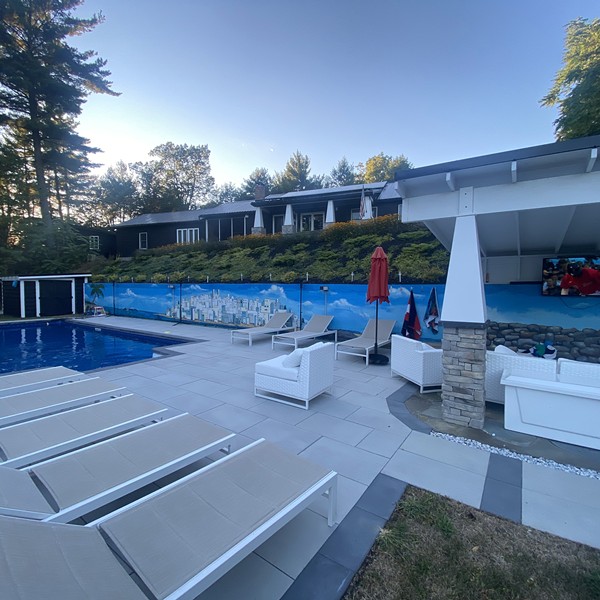There is no subject of more intense debate in the Hudson Valley than housing. Tenants and homeowners are concerned about being priced out. Those hit hardest by the pandemic are worried about being evicted (legally or otherwise). New arrivals are flooding the market, playing a life-altering game of musical chairs with a rapidly diminishing stock of affordable homes. Longtime residents can’t believe the prices. And elected officials, activists, and policy advocates are wondering how to close the affordability gap.
Two weeks ago, Ulster County took its biggest step in addressing the problem—or at least describing it, in great detail, and laying out some potential solutions. On March 4, County Executive Pat Ryan unveiled a Housing Action Plan that examines trends within the county over the past decade—including demographic changes, housing stock, rising costs, and housing needs—and outlines five recommendations to address the problem.
The 144-page report came just after the one-year anniversary of the discovery of the first case of COVID-19 in New York State, but its findings make clear that Ulster County’s housing market “was in crisis even before the pandemic,” as Ryan writes in an introductory letter. (Reporting in The River and elsewhere had reached the same conclusion.)
According to the study, median rent in the county has increased at least 16 percent since 2010, and the average sales price of a single-family home spiked 17 percent from 2013-2019. Meanwhile, household incomes have stagnated or declined for all but the county’s highest earners. Approximately 13 percent of homeowners and a staggering 30 percent of renters are severely cost burdened, meaning they spend more than half of their income on housing.
The data comes from a variety of sources, including the American Community Surveys conducted by the Census Bureau, Department of Housing and Urban Development reports, the county’s annual rental housing survey, and other county real estate and finance databases. It was guided by a nine-member advisory committee charged by Ryan with looking into the causes of the housing crunch and suggesting a range of solutions.
“We know what the problems are—what we need is action,” says Ulster County Deputy Executive Evelyn Wright, who coordinated the advisory committee. “What we decided to do was begin the study with a focus on not just studying the problem but getting to recommendations for action, and also begin taking whatever actions we know made sense right now.”
Among those recommendations are:
- Establish an Ulster County Housing Task Force to support municipal affordable housing efforts and facilitate the development of affordable housing.
- Establish partnerships and collaborate with developers on scattered-site redevelopment.
- Increase the supply of supportive and transitional housing, which would help people who require ongoing support due to mental illness, addiction, or other underlying conditions.
- Create the “Housing Smart Communities Initiative,” by which the county would provide incentives, guidance, and support to communities—including helping develop policy and sharing tools and best practices.
- Establish a housing fund for the county with specific allocation targets, such as assisting nonprofits in developing supportive housing, assistance for homeowners and renters, and helping create new affordable housing and/or preserving existing affordable housing through purchases and rehabilitations.
You can read the full report here.
The River spoke with Deputy County Executive Wright about the study, the “missing middle” in housing, why prices are surging, and what can be done about it. The interview has been edited for clarity and length.
Who initiated the study, and how was it conducted?
The study originated in discussions in the County Legislature’s Economic Development, Tourism, Housing, Planning & Transit Committee around this time last year. One of the things we discussed was, do we need to do a study? We know what the problems are. Thus the focus on getting to recommendations for action.
The first project we embarked on, in terms of taking action right now, was the project to build housing on top of Golden Hill, on the site of the old jail. That was clearly a property the county didn’t need anymore, where it made a lot of sense to essentially build a new neighborhood up there.
That got underway right around the same time as we formed the Housing Advisory Committee and initiated the study. Pattern for Progress [a policy planning and advocacy nonprofit organization] worked with us on this. [Pattern Senior Vice President] Joe Czajka led the effort; myself and Dennis Doyle, the county planning director, were the project managers; and we formed jointly with the legislature a committee of nine folks from all different backgrounds who met with Pattern and us monthly between June and December to guide the study’s questions, review the data with Pattern, talk about the implications, and really shape the strategy.
The data in the report comes mostly from a mixture of publicly available and county data sources. We didn’t go out and do survey work, but we did hold a public hearing, with a small but very engaged turnout, so we heard from some households—personal stories that really added color and context to the data we were gathering.
(The nine-member Housing Advisory Committee included: Debbie Briggs, vice president of human resources and community relations at Ellenville Regional Hospital; Deb Dewan, a member of the Woodstock housing committee; Erica Brown, community outreach coordinator for Radio Kingston; Hayes Clement, a real estate broker; Kathy Germain, vice president of housing service at RUPCO; Laura Petit, an Ulster County legislator; Richard Parete, Marbletown supervisor; Rick Alfandre, CEO of Alfandre Architecture; and Thomas Smiley, CEO of Mohonk Mountain House.)
You said during the presentation of initial findings that you were really shocked by some of the data. What most surprised you?
This chart:
Municipality 2018 Local Median Household Income Median Active Price Active Listings Low High Income Required to Purchase Median Priced Home Required Income for Purchase as % of County AMI Maximum Purchase based on Local Median Income # of Active Listings below Maximum Purchase % of active listings Ulster County $63,348 $375,000 773 $50,000 $6,950,000 $121,000 145% $189,000 66 8.5% C. Kingston $48,186 $268,450 86 $79,500 $2,300,000 $93,000 111% $127,000 1 1.2% V. Ellenville $46,034 $195,900 9 $69,000 $339,000 $70,000 84% $115,000 2 22.2% V. New Paltz $41,753 $529,700 6 $325,000 $849,900 $160,000 191% $109,000 0 0.0% V. Saugerties $44,620 $279,000 18 $165,000 $6,950,000 $87,000 104% $122,000 0 0.0% T. Denning $80,972 $630,000 4 $89,900 $2,250,000 $199,000 238% $249,000 0 0.0% T. Esopus $69,042 $362,000 45 $50,000 $5,900,000 $116,000 139% $210,000 7 15.6% T. Gardiner $75,399 $619,950 28 $54,000 $2,500,000 $196,000 234% $230,000 2 7.1% T. Hardenburgh $50,000 $1,950,000 1 $1,950,000 $1,950,000 $595,000 711% $148,000 0 0.0% T. Hurley $81,125 $359,900 38 $199,500 $2,350,000 $115,000 137% $251,000 5 13.2% T. Kingston $79,583 $344,500 7 $195,000 $465,500 $115,000 137% $234,000 3 42.9% T. Lloyd $69,337 $354,900 44 $158,500 $950,000 $120,000 143% $200,000 2 4.5% T. Marbletown $69,258 $599,000 29 $180,000 $3,500,000 $180,000 215% $222,000 1 3.4%
Municipality 2018 Local Median Household Income Median Active Price Active Listings Low High Income Required to Purchase Median Priced Home Required Income for Purchase as % of County AMI Maximum Purchase based on Local Median Income # of Active Listings below Maximum Purchase % of active listings T. Marlborough $80,353 $379,900 22 $149,000 $1,200,000 $139,000 166% $215,000 4 18.2% T. New Paltz $72,500 $449,000 41 $225,000 $2,500,000 $154,000 184% $205,000 0 0.0% T. Olive $68,285 $484,450 24 $135,000 $1,395,000 $138,000 165% $232,000 3 12.5% T. Plattekill $58,205 $425,000 15 $234,500 $975,000 $144,000 172% $165,000 1 6.7% T. Rochester $60,173 $416,000 40 $115,000 $1,800,000 $126,000 151% $181,000 5 12.5% T. Rosendale $70,566 $269,900 33 $109,900 $2,200,000 $87,000 104% $217,000 7 21.2% T. Saugerties $60,396 $349,900 101 $95,000 $1,900,000 $115,000 137% $178,000 6 5.9% T. Shandaken $39,219 $314,950 36 $95,000 $2,550,000 $95,000 114% $98,000 2 5.6% T. Shawangunk $83,430 $329,500 14 $89,900 $2,025,000 $112,000 134% $243,000 3 21.4% T. Ulster $54,658 $294,500 47 $101,000 $795,000 $99,000 118% $157,000 3 6.4% T. Wawarsing $47,229 $337,000 38 $110,000 $1,950,000 $113,000 135% $125,000 5 13.2% T. Woodstock $73,356 $625,000 47 $225,000 $2,990,000 $179,000 214% $247,000 1 2.1%
The affordability problem is created by two issues that come together: low wages and high prices. This table summarizes the median household income, the median sales price, and the price range in each municipality and the county as a whole. It tells you how much you have to earn for a median-priced home on the market to be affordable. You can see that in the county, you need a median income of $121,000, which is 1.5 times as much as the actual area median income. That’s based on that rough guide of spending 30 percent of income on housing costs.
Then you can see in the green column your max purchase price based on area median income. What share of the listings active on the market in September could you actually have afforded? For the county as a whole, the household making the area median income could afford 8.5 percent of listings. For a number of municipalities, it’s zero percent. This is what shocked me.
Where in the county is the housing crunch most severe? Are there different factors driving the crunch in different places that we can identify?
I would say the crunch is severe everywhere, but there are different needs and different drivers everywhere. In some cases, it’s low incomes, but even in high-income communities, there can be a really high affordability burden because of high prices.
In a lot of parts of the county, we have aging seniors who would love to remain in their communities, but don’t really want to remain in the single-family homes they’re in. Maybe they want to be someplace that requires less maintenance, is more walkable, or is just smaller. If we can help them move into the places they would rather be, then their homes would be freed up for young families. So it’s a knock-on effect.
Overall, we need to look at who are the populations, what do they specifically need, and what should we be thinking about trying to get built for them? We’re encouraging all the municipalities in the county to have a community-by-community conversation about this, because the needs are different in terms of who needs what.
One of the other things you talked about in the committee presentation was the “missing middle”—a mismatch of housing type and demand. Can you elaborate on what that means specifically for Ulster County?
We’ve been talking about the housing affordability crisis. But we need to rearrange those words, “affordable” and “housing,” because that’s what we have: an affordable housing crisis across the spectrum, up to the high end. We’re not just talking about folks making half of the area median income, although their need is critical and dire—even if you’re making the median income, and sometimes considerably above that, you’re out of luck.
Over the last couple of decades in Ulster County, we’re really only building homes at the very high end. New homes are large homes on 10-acre lots selling for $750,000 or more. That’s driven by a combination of factors, including land-use decisions and zoning requirements. We’ve been really successful at preventing the kind of sprawl that has decimated other communities, and we did a really good job of making sure that we didn’t just build slapdash all over the place. And the result is that we have built hardly anything, and since we tend to require building on large lots, that lends itself to higher-end homes.
The other thing is that not only are land costs high, but building costs are very high. The cost of construction and of getting through the approval process adds a lot of time and uncertainty to projects. So developers look at our land use and our cost drivers, and they say, “I want to be at the high end of the market, where the profit margins are higher. I’ll make more money per dollar of investment building a high-end home than a home in the middle.”
So that’s what we mean by “missing middle.” We’re not just talking about low-income housing; we’re not building the housing that the vast majority of folks in the community need.
What are some things that can be done to incentivize building more toward that missing middle?
The very first thing, and a key role for the county, is kicking off a community-wide conversation about how severe this crisis is and the need to take action on it. Our local land-use decisions have been driven by the loudest voices being the objections of people who live next door to or across the river from a proposed project and don’t like it. We don’t have the clamor for getting things built and solving this crisis that we need to have. When we do it in a one-off, project-by-project way, the voices are all on one side of the equation.
The county executive is reaching out to elected officials, business leaders, and folks in the education and health communities to talk about how we all need to get together and get serious about tackling this problem. We had one of the biggest employers in the county [Thomas Smiley, CEO of Mohonk Mountain House] on the housing advisory committee saying, “I literally can’t fill even well-paying positions because folks cannot find a place to live.” (In a press release announcing the plan, Smiley said “as an employer, I have seen firsthand how our housing shortage is impacting our ability to attract and retain workers.”)
I’ve heard the same from other large employers in the region, especially the schools and hospitals. This is not just a moral crisis, it’s not just an issue of compassion—this is really going to hold our economy back.
So you’re saying it’s partly a matter of framing and messaging: When you talk about a particular project, during the public comment period the NIMBY voices will be loudest. But if any given project is instead framed as part of a larger move toward affordability and a more sustainable economy, the conversation changes.
That’s right. Because these decisions are made on the municipal level [given New York’s home rule power, which grants decision-making authority to local governments], what the county is proposing to do is to support municipalities in taking a thorough look at their existing zoning and regulations, and where they could make changes to encourage more development of the type they want. To get to the point where, community by community, we have a conversation about what we need to build, who the populations in need of housing are, and where it makes sense to build. Let’s also have a conversation about what land we should be protecting, and what land we should be building on.
This is what the comprehensive planning process is supposed to do, but in many of our communities, building housing was not prioritized in that process in recent decades. So we’re going to be helping communities with technical support, financial support, and mapping support to do those assessments, and then go out to put out a request to developers to say, “We want to build this type of housing on this site,” rather than just passively waiting for developers to propose something and then having a series of one-off fights about particular projects.
We’re putting together a menu of actions that municipalities can take. That starts with creating a committee and making a commitment to look at this issue. That could involve looking at regulatory changes like zoning, short-term rental regulations, and changing the permitting parameters for accessory dwelling units [smaller residential dwellings located on the same lot as a single-family home]. For example, different kinds of zoning could be introduced to offer density bonuses, to offer an “overlay” for affordable housing, to designate places in the municipality where you can build certain types of affordable housing. [Overlay zones build on the underlying zoning, and establish additional or stricter standards and criteria.]
This is all at the municipal level. What the county planning department and planning board can do is help municipalities work through that—let them know about best practices elsewhere, help them review the codes they have, and suggest alternatives. But ultimately, it’s town by town.
We also need to increase the supply of supportive and transitional housing. Are there any things happening on the municipal level that seem promising to that end right now? What do you think municipalities could do to help folks in the coming months?
The tricky thing in the past with transitional and supportive housing has been siting. Wherever it’s proposed to put something, there are neighbors who don’t want it. That has been the dynamic that has kept us from building more transitional and supportive housing in the county in recent decades.
Changing that really has to be part of the community-level commitment. The county is ready to help—if communities identify a site, we can help put out a request for qualifications to developers, we can help work through the various funding sources out there. But that commitment to site a project somewhere has to be made.
We’ll be including some supportive housing in the Golden Hill project, and we’re on the lookout for other sites and other partners we can do that with.
Are there initiatives happening on the municipal level or via nonprofits that you think are promising? There has been some discussion about tiny homes in Kingston, but I know that is running into roadblocks with the city government right now.
One proposal I’ve heard out of Kingston and Woodstock—where they have a very active community-level housing committee—is to look at ways to build more accessory dwelling units on existing home sites. Communities have different regulations around those: In Kingston, you still need a special permit to build one, but there are other communities that have made it easier. I’ve heard discussion, for Kingston, of trying to make that permitting process easier and creating mechanisms for philanthropic funding to help homeowners build accessory dwelling units, with a commitment to some period of time of affordable rents for them. I think that kind of nimble in-fill development could be one way to more rapidly increase the supply.
I wanted to ask about the concept of a “just transition.” I feel like it’s important to connect the affordability crisis with the need to diversify the economy and rethink how capital works. That was something you were working on before you were Deputy County Executive, and Pat Ryan said it would be part of your portfolio when you were hired. Obviously the pandemic has upended best-laid plans, but as we look to a more hopeful future, I'm wondering what proposals and changes to that end you're hoping to take up this year, and if any of those could alleviate the housing crisis.
Last fall, we released the Ulster 2040 economic development plan, which targets four clusters of our economy where we’re focused on diversification and quality of life for everybody here: Agriculture, Food, and Beverage; Makers and Creators; Clean Energy and Environment; and Health, Wellness, and Care. Though in all of our economic development efforts, we are certainly focused on investing in projects and targeting our support to those parts of the economy that are diversifying and creating high-quality jobs.
I would love us to do more work around cooperatives; it’s not something we’ve had a chance to do, although we are eager to support folks in the community working on that. I’m right now working on our Green New Deal plan, which will be released on Earth Day. It puts a strong focus on workforce development and how all of the work we need to do to transform our energy system and stabilize our climate creates enormous economic opportunity. We need to mobilize county, state, and federal funds to retrofit our homes, install solar panels and heat pumps, and electrify our transportation. All of that is going to create local jobs. We’re really focused on both sides—supply and demand—of that workforce growth.
Tourism drives a huge amount of the economy up here, but the data shows that Airbnb and other short-term rentals lead to inflated housing costs. Are there things you might recommend municipalities do to stanch the worst impacts?
We didn’t have data where we could directly tie the number of short-term rents to changes in long-term rents, but without question it’s one of the driving factors [of unaffordability]. We can all see that when units are converted to short-term rentals, that obviously takes them off the long-term market and impacts rents.
Looking at short-term rental regulations is one of the recommendations we have, and [County Planning Director] Dennis Doyle has a really good idea for that: Municipalities can cap the number of short-term rentals available in the town, which some have done, and then let that cap grow as new long-term rentals come on the market. In other words, if we successfully build the housing we need, then we have room to create more short-term rentals. In context, that could be a good tie-in.
It seems like people in the community really care about this, and there are good ideas out there. Do you feel optimistic about how the community’s participation in these discussions will go?
To use an overused phrase, I am cautiously optimistic. I’m also hearing what you’re hearing in terms of the level of engagement, and I can say that all the work we’ve done at the county on housing has been a rare outbreak of unanimity among the executive branch and all of the legislature. Folks have been really united on how serious this is. I also hear that when I talk to town supervisors. It’s on everybody’s mind.
But we are fighting upstream against 21st-century American capitalism. This is happening to us because we are a low-wage place facing an influx of high-wage earners. And it’s actually happening to us fairly late—I think our weather and our aging building stock protected us for a long time. My aunt lives in northern Idaho, and Californians were ruining 10 different Western states in the 1990s, making lots of money in California and moving to Idaho, Utah, Wyoming, Montana. We really got away with our little protected paradise for a very long time compared to many other places in the country.
We’re at such an unusual moment in this country; it’s really hard to know what’s going to happen next. I feel really great about the community energy here, and how determined folks really are to make a difference. I’m optimistic at least that we’re going to do our best. We’re going to need a lot of creativity.
I’m curious if you’ve heard ideas that you like? What do folks want to see happen?
I like the land bank approach. The issue is you can’t scale it to the size of the problem, and I know the study indicates that it doesn’t seem likely that we’ll get a county land bank here.
I think land banks have been especially effective in places where there was a large amount of vacant housing that nobody wanted, but unfortunately that’s not where we are in Kingston right now. That’s one of the reasons we haven’t been more aggressive in trying to make the land bank solution work. I told the committee that I think we can do with the housing development corporation we formed for the Golden Hill project many of the things the Kingston Land Bank is doing in Kingston, although the scale is an issue.
This is not county officialdom, but I was recently turned onto an organization called the Incremental Development Alliance. They were formed by folks who started as small-scale private redevelopers in a number of communities that were hard-hit and had lots of neglected real estate. The IDA developed its own theory of how such private, small-scale developers could generate housing supply and improve their neighborhoods by being committed to a neighborhood. Redeveloping or rehabbing homes from single-family up to buildings with 10 to 12 units that fit into the existing vocabulary of a neighborhood. Duplexes, four-plexes: that kind of building increases density without building giant projects. What they say is if we want to do this at scale, what we need is a small army of individual private developers who are committed to their neighborhood and are doing this because, yes, they think they can make money, but in a way that’s also committed to making the neighborhood a better place. I think there’s something compelling about that.
IDA goes around the country giving trainings to folks who want to be that kind of developer, and to municipalities about how they can revise their zoning to make it easier to build this kind of development. They point out that the stuff we were building 60 and 80 and 100 years ago has created the neighborhoods and Main Streets we like, but mostly we zone that kind of building out now.
To be clear, this approach is not something the county is actively working on at this time. But maybe we should look at what we like about those old neighborhoods and think about how we could build things that look like that now.







